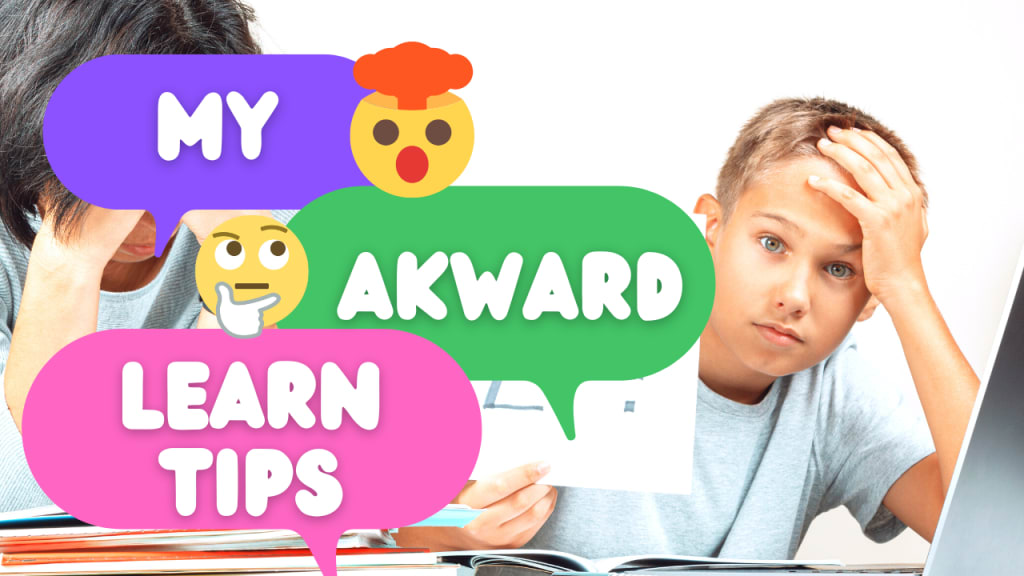Difficulty learning? You've definitely never heard of these learning methods
I show you 10 akward learn tips for you and your child

As someone who's struggled with academics throughout her education journey, I know firsthand how difficult and frustrating it can be to feel like you're not learning as quickly or effectively as everyone else. But I also know that there are methods out there that can help even the most struggling students learn more effectively.

Why is it so difficult for us to learn?
There are a number of reasons why learning can be difficult for some people. It could be because of the way our brains are wired – some people simply learn differently than others. Or it could be because of outside factors, like having a chaotic home life or not having access to resources like quality education or tutoring.

Whatever the reason, if you're finding it difficult to learn, don't give up – there are ways to make learning easier and more effective for you. Try out some of these unique methods and see how they work for you!
1. The Pomodoro Technique
This time management strategy is designed to help you focus on a task for 25 minutes, then take a 5-minute break before starting the next 25-minute interval. The theory is that by breaking up your work into manageable chunks, you'll be able to focus more effectively and get more done. Plus, the regular breaks will help to keep you from feeling overwhelmed or bogged down by the task at hand.
2. The Feynman Technique
Named after Nobel Prize-winning physicist Richard Feynman, this technique is designed to help you simplify and better understand complex concepts. To use it, first explain the concept to yourself as if you were teaching it to someone else. Then, identify the areas where you got stuck or felt unsure in your explanation. Finally, go back and fill in those gaps in your understanding by doing additional research or asking a teacher or tutor for help.
3. Spaced Repetition
This is a memory technique that involves spreading out your review of material over time, rather than trying to cram everything in right before a test or exam. The idea is that by revisiting information periodically, you'll be better able to recall it when you need it. There are a number of apps and online tools that can help you with this, such as Anki, SuperMemo, and Quizlet.
4. The Feynman Point
Named after Richard Feynman again, this learning method is all about understanding why something works, rather than just being able to recite the steps. To use it, first explain the concept to yourself in layman's terms. Then, identify the key points that you're still unsure about and do additional research or ask a teacher or tutor for help in understanding those points.
5. The retrieval practice technique
This is another memory technique, similar to spaced repetition. However, instead of spreading out your review of material, you focus on retrieving information as often as possible. This can be done by regularly testing yourself on material, such as through flashcards or practice questions. The more you retrieve information, the better you'll be able to remember it when you need it.
6. The Elaboration Technique
This technique is all about making connections between new information and what you already know. To use it, first learn the new material. Then, take some time to think about how it relates to other things that you know. Make connections between the new information and what you already know by brainstorming or writing down your thoughts.
7. The Concrete-Pictorial-Abstract Approach
This is a teaching method that involves introducing concepts first in a concrete way, then in a pictorial way, and finally in an abstract way. For example, if you were trying to learn about the concept of addition, you might start by using physical objects to add up, then move on to pictorial representations of addition, such as a number line or addition table. Finally, you would learn the abstract concept of addition, which is the ability to add numbers without any physical or pictorial representation.
8. The Mnemonic Devices Technique
This is a memory technique that involves using a device, such as a rhyme or acronym, to help you remember information. For example, the acronym "Roy G. Biv" is often used to help remember the colors of the rainbow (red, orange, yellow, green, blue, indigo, violet).
9. The Mind Mapping Technique
This is a brainstorming technique that involves creating a visual representation of your thoughts, ideas, or concepts. To create a mind map, start by placing the main idea in the center of a piece of paper. Then, draw lines out from the center and write down related ideas, concepts, or keywords. Finally, add additional details and information to those ideas.
10. The SQ3R Technique
This is a reading comprehension technique that involves survey, question, read, recite, and review. To use it, first survey the material you're going to read by skimming through it or looking at the chapter headings and subheadings. Next, generate questions about the material. Then, read the material and try to answer those questions. After reading, recite the main points of the material out loud or in your head. Finally, review the material by taking practice quizzes or doing additional research.
Tips for learning disabilities in Children
There are a number of different learning disabilities that can affect children. These include dyslexia, ADHD, and ASD. However, there are some general tips that can help children with any learning disability:

1. Get organized
One of the most important things you can do is to help your child get organized. This includes teaching them how to keep track of their schoolwork and materials, as well as helping them to plan and structure their time.
2. Encourage active learning
Instead of simply having your child sit and listen to a lecture, encourage them to actively engage with the material. This can be done through activities, discussions, and other hands-on methods.
3. Use different learning modalities
Children often learn best when they can use multiple modalities, or senses. This means using a variety of methods to present information, such as through visual aids, hands-on activities, and auditory explanations.
4. Provide accommodations and support
There are a number of accommodations and support strategies that can be very helpful for children with learning disabilities. These include things like extra time on tests, modifying assignments, and using assistive technology.
5. Help them to develop self-advocacy skills
It is also important to help your child develop self-advocacy skills. This means teaching them how to communicate their needs, ask for help when they need it, and advocate for themselves in general.
what tips help with learning difficulties at work?
There are a number of things that can help with learning difficulties at work:
1. Make sure you understand the task at hand. If you don't understand something, ask for clarification.
2. Break down the task into smaller, more manageable steps. This will make it less overwhelming and easier to complete.
3. Write down what you need to do and check off each step as you complete it. This will help you to keep track of your progress and feel a sense of accomplishment.
4. Take your time and don't try to rush through the task. This will only lead to mistakes and frustration.
5. Ask for help if you need it. There is no shame in admitting that you need assistance and there are people who are more than willing to help.
Hopefully, one or more of these learning methods will work for you. If not, there are plenty of other techniques out there to try. The important thing is to find a method that works for you and stick with it. With enough practice and perseverance, you'll be able to learn anything you set your mind to. Good luck!
Love You <3
Jess
About the Creator
Jessica Lender
I'm Jesssica Lender, a mother and an expert on blogging. I love writing, and I love helping others learn how to write well too. That's why I blog and write articles myself- to help others learn the ropes of this amazing industry!






Comments
There are no comments for this story
Be the first to respond and start the conversation.